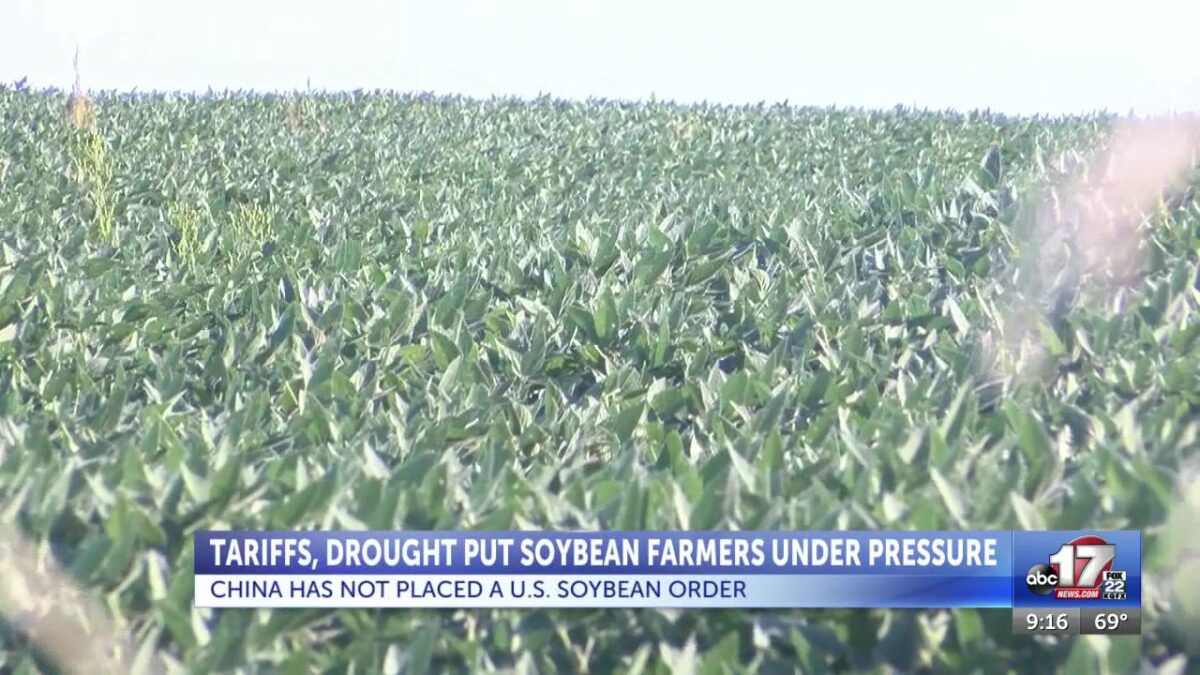Tariffs, drought put Missouri soybean farmers under pressure

Mitchell Kaminski
COLUMBIA, Mo. (KMIZ)
During a town hall in Harrisburg on Aug. 27, Troy Douglass went to the microphone to address Rep. Mark Alford (R-MO).
Douglass — a lifelong farmer with farms in Boone, Howard and Randolph counties — was concerned about the future of his business. Missouri ranks seventh in the U.S in soybean production with more than 22,000 farms across the state, the sixth highest in the nation.
On April 2, President Donald Trump levied a 34% tariff on all Chinese goods. Two days later, China responded with a retaliatory tariff on all US imports.
The retaliatory tariffs have placed U.S soybean farmers at a 20% disadvantage compared to South American competitors. As a result, China has begun buying soybeans from Brazil, which shipped nearly 16 million tons of soybeans to China in March, its largest monthly volume ever.
But with the U.S. harvest season approaching, China, once America’s top soybean customer, hasn’t placed a single order.
“This tariff deal really affects my world. I feel like you’re skirting the issue of China. They are the number one buyer of soybeans, number three buyer of corn,” Douglass said at the time. “Trump says two weeks ago he wants to triple China’s buying of soybeans. Well, zero times three is still zero.”
But that wasn’t the only issue Douglass was concerned about. Tariffs from Trump’s “liberation day” have driven up the cost of fertilizer and farm materials. Douglass argued that most of the fertilizer he purchased comes from Canada, with some of it coming from Russia. However in the last year prices have doubled.
Douglass pointed to the cost of anhydrous, which is used to help improve nutrients in soil.
“Usually, you can buy your anhydrous in the fall for about $450 to $650 in the fall. It’s not even fall and it’s $650 today,” Douglass said at the time. “It takes about $850 to plant an acre of soybeans if you do it right. The tariff affects the farmer both ways. You can call it a revenue stream. You can say that it is passed on or the companies eat it, I’m telling you, fertilizer, chemical, seed, all that stuff is manufactured and grown, most of it overseas.”
Douglass later added that many tractor suppliers are struggling to buy parts.
Douglass is facing an issue that many farmers across the country are facing. On Aug. 19, Caleb Ragland, president of the American Soybean Association, sent a letter to Trump warning U.S soybean farmers were standing at a “trade and financial precipice.”
“Soybean farmers are under extreme financial stress. Prices continue to drop, and at the same time, our farmers are paying significantly more for inputs and equipment. U.S. soybean farmers cannot survive a prolonged trade dispute with our largest customer,” Ragland wrote.
The issue isn’t new. During the 2018 U.S.–China trade war, American farmers lost an estimated $9.4 billion, according to the USDA.
In Missouri, the concerns come as soybean yield forecasts are projected to drop. A September report from the University of Missouri projects yields averaging 3-to-6 bushels per acre lower than the previous estimate.
According to MU Extension soybean agronomy specialist Andre Reis, this comes despite expecting higher yields than normal early in the growing season.
“We were expecting to have higher yields than normal. But then in August, August was the second-driest year in Missouri since we started to record weather data,” Reis said. “During August and in early September, this is the phase when soybeans are using the maximum amount of water per day, the maximum demand and we didn’t have rains, so the drought affected the soybean crop.”
According to Reis, two components that decide what the soybean yield will be are the number of seeds per area and seed size. The size of the seeds is usually determined in August. Due to the lack of rains, Reis believes the yields will be lower this year than the historical average.
“We can all agree that the price commodity is not great at this point. And part of it is because of the trade war with other countries,” Reis explained. “And then when we have the perspective of not having enough yield, that really puts the farmers in a difficult situation to invest or prepare themselves for the next season. So it’s very hard to tell what’s going to be the impact for the next two seasons. At this point, there is no clarity if there will be any impact, but it’s going to be a perfect storm brewing.”